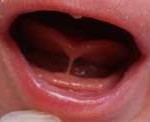 Being tongue tied is more than just not knowing what to say. It is an actual medical diagnosis (ankyloglossia) that is not that uncommon. (estimates are one in one to two thousand people) In my Indianapolis plastic surgery practice, I have seen lots of them over the years. It is a condition inside the mouth where the tip of the tongue is tethered down to the floor of the mouth. It is marked by an inability to move the tongue beyond the front teeth…..or just barely past them. When there is an attempt to stick the tongue out, a V-shaped notch appears at the tip. Technically, it occurs when the lingual frenulum (on the underside of the tongue) is either too short or anteriorly placed , restricting the mobility of the tongue.
Being tongue tied is more than just not knowing what to say. It is an actual medical diagnosis (ankyloglossia) that is not that uncommon. (estimates are one in one to two thousand people) In my Indianapolis plastic surgery practice, I have seen lots of them over the years. It is a condition inside the mouth where the tip of the tongue is tethered down to the floor of the mouth. It is marked by an inability to move the tongue beyond the front teeth…..or just barely past them. When there is an attempt to stick the tongue out, a V-shaped notch appears at the tip. Technically, it occurs when the lingual frenulum (on the underside of the tongue) is either too short or anteriorly placed , restricting the mobility of the tongue.
Tongue-tie most commonly appears as a partial restriction and rarely as a complete fusion. There is considerable controversy as to what functional problems that it may or may not cause. It has been implicated in speech defects, breastfeeding difficulties, and a source of dental problems. While I have seen and treated many tongue-ties in babies and young children, the few I have seen in adults did not appear to be causing any significant problems. The main reason tongue-ties are treated is for better tongue mobility which has a cosmetic benefit and probably some minor functional improvement as well.
The main reason to treat tongue-tie, in my opinion, is the sheer simplicity of doing it without postoperative complications or relapse. One can have a lot of debate as to whether it is medically necessary, but if you can eliminate the problems with a very simple and quick procedure, that debate takes on less significance.
Tongue-tie is released through a procedure known as a frenuloplasty or frenectomy. The frenulum is incised near its midportion until the tongue is fully released. Then it is sewn together with small resorbable sutures creating a long unrestricted frenulum. In babies and children this requires a general anesthetic. In adults, it can be done under local anesthesia in the office.
Dr. Barry Eppley
Indianapolis, Indiana


